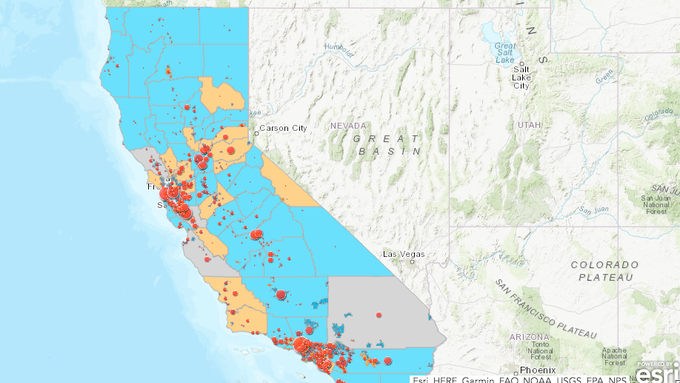
An interactive map helps developers learn whether communities are in compliance with a state housing mandate, made possible by Senate Bill 35, one of the 15 bills that made up the 2017 Housing Package.
During the 2017 session of the California Legislature, lawmakers authored 15 bills aimed at tackling the state’s housing crisis and delivered them to Gov. Jerry Brown, who signed them on Sept. 29, 2017. It was an extraordinary achievement that had been in the works for years, as some of the new laws evolved out of legislation that had failed previously.
The California Department of Housing and Community Development said the package delivered “an injection of new regulatory and financial resources, and, with it, an opportunity to increase supply and innovate delivery throughout the state.”
The need for such an injection was obvious, and the department spelled out the cause:
California has a very low supply of new homes compared to need. The state averaged less than 80,000 new homes annually over the last 10 years—less than half of the projected need. Further, production is less than half of what California was building during most of the 20th century.
There are an estimated 1.5 million low-income California households that pay more than half of their income for housing costs. California also has the largest homeless population in the country, which research suggests is a direct outgrowth of our housing costs.
The Housing Package
The 15 laws contained two significant sources of money, including a sizable one-time infusion (a $4 billion bond) and a mechanism for generating ongoing revenue (a real-estate transaction fee).
Perhaps more importantly, one hard-fought ordinance, Senate Bill 35, aimed to reduce hurdles to homebuilding by allowing developers to bypass some local regulations when building affordable apartment complexes.
Other bills were intended to ensure that homes for all income levels get built.
Details on key laws in the housing package are described briefly below. For a deep dive into the package, check out this comprehensive analysis prepared by the housing department.
SB 2—Building Jobs and Homes Act (Toni Atkins, D-San Diego)
What might appear to be a wonky bit of bureaucratic fiddling actually creates a powerful revenue stream and targets the money exactly where it’s most needed.
SB 2 imposed a $75 fee on the recording of real estate documents, such as escrows and refinances, and earmarks the revenue for affordable housing. Legislative analysts estimate the annual revenue to the Trust Fund established by the law at $200 million to $250 million annually.
Seventy percent of the proceeds are allocated to local governments to pay for a variety of housing activities, depending on the needs of each community. Various state agencies get 30 percent to fund farmworker housing, incentive programs, and mixed-income multifamily housing developments.
SB 3—Veterans and Affordable Housing Bond Act (Jim Beall, San Jose)
This law placed a $4 billion general obligation bond on the November 2018 ballot. Prop 1, which passed, allocated $3 billion to programs that assist affordable multifamily developments, housing for farmworkers, transit-oriented development, infrastructure for infill development, and homeownership. It also funded matching grants for Local Housing Trust Funds and homeownership programs.
Another $1 billion in bond proceeds was allocated to CalVet to assist veterans in purchasing homes and farms.
SB 35—Streamline Approval Process (Scott Wiener, D-San Francisco)
Background: In 1969, the state of California mandated that all cities, towns and counties plan for their housing needs. The Regional Housing Needs Allocation, or RHNA, determines the number of homes a community needs to build to meet the needs of residents at all income levels.
Most California municipalities have not come close. So, in SB 35, RNHA meets YIMBY.
Sen. Wiener, a former San Francisco supervisor, has been at war with NIMBYism for more than a decade. In a press release accompanying the introduction of his bill, Wiener said, “SB 35 will retain local control for those cities that are producing their share of housing, but create a more streamlined path for housing creation in those cities that are blocking housing or ignoring their responsibility to build.”
SB 35 allows developers to submit an application for streamlined approval processes for projects that meet specific criteria. If the development meets all state-mandated criteria, localities must approve the project in either 60 days if the development contains less than 150 housing units or 90 days if the development contains more than 150 units of housing. Bam!
Long form articles which explain how something works, or provide context or background information about a current issue or topic.